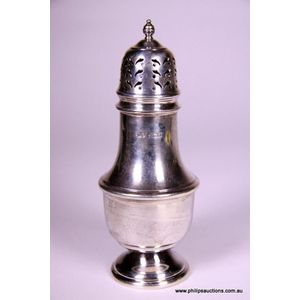Elegant Sterling Silver Sugar Caster, London 1937/38
You must be a subscriber, and be logged in to view price and dealer details.
Subscribe Now to view actual auction price for this item
When you subscribe, you have the option of setting the currency in which to display prices to $Au, $US, $NZ or Stg.
- Sterling Silver - Sterling silver is a mixture of 92.5% pure silver and 7.5% of another metal, usually copper. Fine silver is 99.9% pure silver, and is relatively soft and the addition of the very small amount of copper gives the metal enough strength and hardness to be worked into jewellery, decorative and household objects.
- Diaper Motif - The diaper motif is a repeating geometric pattern in decorative arts that consists of small diamond or lozenge shapes arranged in a grid. The pattern is often used as a background or border on textiles, ceramics, metalwork, and other decorative items. It can be found in a variety of cultures and historical periods, and is often used in formal or ornamental designs. The name "diaper" comes from the pattern's resemblance to the criss-crossed fabric of a baby's diaper.
- Caster - Casters are so-called because they ?cast? their contents over food. They consist of a container, usually in silver or pewter with a removable perforated top which allows for the sprinkling of condiments such as sugar, pepper and nutmeg.
- Hallmarks - A mark stamped on articles of precious metals in Britain, since the 14th century, certifying their purity. It derives its name from the Guild Hall of the Goldsmiths' Company, who recieved its Charter in 1327 giving it the power to assay (test the purity) and mark articles of gold and silver.
The hallmark will consist of several marks, including the:
- silver standard mark, indicating the purity of the metal. Sterling silver is .925 pure silver.
- the city mark indicating the city in which it was assayed eg London, Birmingham, York etc.
- the date mark, usually a letter of the alphabet in a particular font and case,
- a duty mark, indicating whether duty had been paid to the crown, and only in use from 1784 to 1890
The piece may include an additional mark, the maker's mark, although not forming part of the hallmark, will be located in the vicinity of the hallmarks.
Sometimes silver plated items will bear faux hallmarks, often confusing those not familiar with silver markings.
This item has been included into following indexes:
Visually similar items

A fine early George II sterling silver sugar caster, 1744 London, with maker's mark probably for Thomas Gilpin, of typical baluster form with a contemporary coat of arms to the body, a pierced dome lid with knopped finial and raised upon a stepped circular

A sterling silver Pillar pepper pot, 1989 Birmingham, with maker's mark for Elkington & Co, of traditional elongated pear shaped form with a waisted foot, having a pierced top and tiny finial, silver weight 90gr. Height 15 cm

A sterling silver sugar caster 1961/2 Sheffield, with maker's mark for Edward Viner. Of carinate form with a pierced dome lid with finial and raised on a stepped spreading base; crisply hallmarked to the body. Silver weight 142gr. Height 17.5 cm

A sterling silver sugar caster, 1959 Birmingham, with maker's mark for Suckling Ltd, an elegant pillar caster of typical form with a decorative pierced top, rib and gadroon borders to the lid, collar and lemon squeezer base; hallmarked to body. Silver weig
